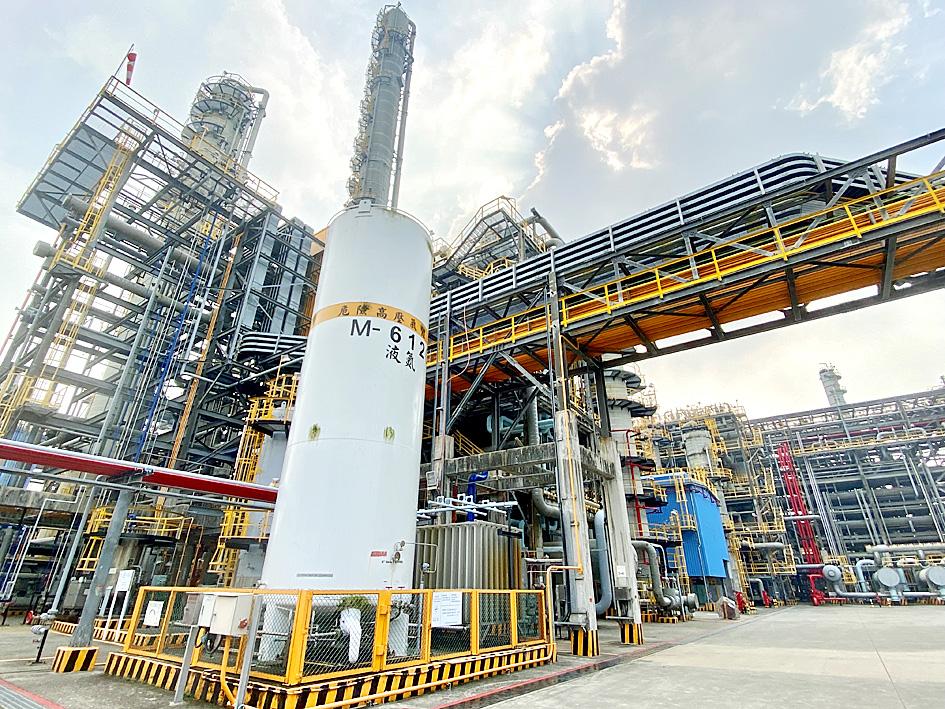As crude oil prices rise sharply this year due to the war in Ukraine, the value of Taiwan’s oil imports surged by 75.6 percent to US$11.9 billion in the first five months of this year compared with the same period last year, the Ministry of Finance said in a report on Thursday.
The import value is expected to reach from US$28 billion to NT$31 billion by the end of the year, the highest in eight years, the ministry said.
Taiwan is almost entirely dependent on imports for its oil supply, the ministry said, adding that the import volume was stable from 2012 to 2019, at above 300 million barrels a year, while the import value fluctuated with changes in international oil prices.

Photo: Hung Chen-hung, Taipei Times
Taiwan last year imported 282.88 million barrels of oil, up 6.6 percent from a year earlier, while the import value rose 59 percent to US$19.9 billion, as the reopening of major economies boosted crude oil prices, the ministry said.
That was in contrast to 2020, when the nation imported 265.26 million barrels of oil, down 18 percent from a year earlier, while the import value plunged 41.5 percent to US$12.5 billion, the lowest in 18 years, after responses to the spread of COVID-19 wreaked havoc on the global economy and severely dented oil demand and prices, the ministry said.
Oil imports this year have extended momentum from last year, as the war in Ukraine drove oil prices to more than US$100 per barrel, it said.
The nation imported 121.86 million barrels of oil in the first five months, up 10.9 percent from a year earlier, at average prices of US$97.80 per barrel, the ministry said.
Most of the nation’s oil imports came from the Middle East, with Saudi Arabia accounting for 34.5 percent and Kuwait contributing 20.1 percent in the first five months, while those from the US comprised 21.1 percent of the total during the first five months thanks to an increase in shale oil imports, it said.
Taiwan’s exports of refined petroleum products also have a high correlation with oil prices, the ministry said. In 2013, exports of such products reached US$22.9 billion, but dropped in subsequent years, with the value falling to US$5.7 billion in 2020, the lowest in 17 years, it said.
Exports of refined products last year increased 68.8 percent from a year earlier to US$9.7 billion, and increased 100.5 percent to US$6.5 billion in the first five months of this year, of which diesel exports accounted for 55 percent of the total and gasoline products comprised 20 percent, the ministry said.

AI TALENT: No financial details were released about the deal, in which top Groq executives, including its CEO, would join Nvidia to help advance the technology Nvidia Corp has agreed to a licensing deal with artificial intelligence (AI) start-up Groq, furthering its investments in companies connected to the AI boom and gaining the right to add a new type of technology to its products. The world’s largest publicly traded company has paid for the right to use Groq’s technology and is to integrate its chip design into future products. Some of the start-up’s executives are leaving to join Nvidia to help with that effort, the companies said. Groq would continue as an independent company with a new chief executive, it said on Wednesday in a post on its Web

RESPONSE: The Japanese Ministry of Finance might have to intervene in the currency markets should the yen keep weakening toward the 160 level against the US dollar Japan’s chief currency official yesterday sent a warning on recent foreign exchange moves, after the yen weakened against the US dollar following Friday last week’s Bank of Japan (BOJ) decision. “We’re seeing one-directional, sudden moves especially after last week’s monetary policy meeting, so I’m deeply concerned,” Japanese Vice Finance Minister for International Affairs Atsushi Mimura told reporters. “We’d like to take appropriate responses against excessive moves.” The central bank on Friday raised its benchmark interest rate to the highest in 30 years, but Bank of Japan Governor Kazuo Ueda chose to keep his options open rather than bolster the yen,

Global server shipments are expected to surge to 15 million units next year, from 4 million units this year, with artificial intelligence (AI) servers accounting for about 30 percent, driven by massive capital spending by major cloud service providers, the Market Intelligence and Consulting Institute (MIC) said on Thursday last week. Major cloud service providers — including Google’s parent company Alphabet Inc, Microsoft Corp, Amazon.com Inc and Meta Platforms Inc — are projected to budget US$450 million for capital expenditure next year, up from US$400 million this year, MIC ICT [information and communications technology] Industry Research Center director Edward Lin

Even as the US is embarked on a bitter rivalry with China over the deployment of artificial intelligence (AI), Chinese technology is quietly making inroads into the US market. Despite considerable geopolitical tensions, Chinese open-source AI models are winning over a growing number of programmers and companies in the US. These are different from the closed generative AI models that have become household names — ChatGPT-maker OpenAI or Google’s Gemini — whose inner workings are fiercely protected. In contrast, “open” models offered by many Chinese rivals, from Alibaba (阿里巴巴) to DeepSeek (深度求索), allow programmers to customize parts of the software to suit their